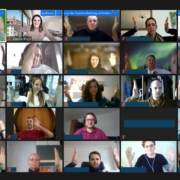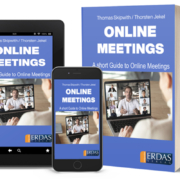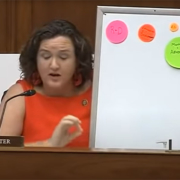What should the background look like online?
/in English, Instructional video, Presentation Skills, Presentation skills coaching, Tips and tricks, Tips for success, Training letter, Video /by Thomas SkipwithHow many slides should you show in a presentation?
/in English, Instructional video, Presentation Skills, Presentation skills coaching, Tips and tricks, Tips for success, Training letter, Video /by Thomas SkipwithHow many slides should you show in a presentation?
When will you give your next proposal presentation, your next pitch? Here’s a tip I highlight with my colleague Sandra Kuhn-Schulthess in the video below.
See the video here.
Task:
1. watch the short video. It takes only 2:30 minutes.
2. consider if and how you can implement the tip.
If you need support, we are ready for you.
Conclusion: With very simple means you can make an impression on the audience and be remembered.
If you also see potential for improvement in yourself or others, I recommend the book “30 Minutes Online Meetings” by Thorsten Jekel and myself. Available in German and English.
I wish you the best of luck with your next presentation, whether online or in person.
Your
Thomas Skipwith
Put your words into action.
/in English, English, Instructional video, Presentation Skills, Presentation skills coaching, Tips and tricks, Tips for success, Training letter, Video /by Thomas SkipwithCEO torn apart in the air
/in English, Instructional video, Presentation Skills, Presentation skills coaching, Tips and tricks, Tips for success, Training letter, Video /by Thomas SkipwithArmin Laschet versus Friedrich Merz: This is where the speakers’ chaff is separated from the wheat.
/in English, Feedback, Instructional video, Presentation Skills, Presentation skills coaching, Tips and tricks, Tips for success, Training letter, Video /by Thomas SkipwithArmin Laschet was elected chairman of the CDU Germany on January 16, 2021. He prevailed over his main rival Friedrich Merz. From a rhetorical point of view, I’m not surprised for a second. Why? You will find out in this article.
Armin Laschet’s speech was worlds better than that of Friedrich Merz. I suspect that Armin Laschet took a coach for this speech.
How do I compare the two speeches? I could easily list 20 points that struck me as positive in Laschet’s speech. At this point, only a few.
| Armin Laschet | Friedrich Merz |
| Really good: Armin Laschet makes a lot of eye contact with the audience behind the camera. | Not ideal: Friedrich Merz often looks sideways at those present in the room instead of into the camera. |
| Both could speak even more freely if they had a teleprompter (or two) installed. That’s how Barak Obama has done it over and over again. Nevertheless, the point goes to Armin Laschet. Especially because he speaks the ending without reading. | |
| He uses his father’s story in underground mining as an analogy for what really matters: Trust. | Friedrich Merz needs practically no stories and no analogies. Therefore, no pictures arise in my head. But these would be important. The whole speech is too abstract, too general. |
| The camera settings are well chosen. | In his place, I would have had a word with the picture director beforehand and certainly afterwards. The attitudes were consistently to his detriment: for example, several times we got to see bored party members or those who were doing something other than listening with interest. |
| Laschet cleverly put the recommendation to vote for him in the mouth of his father (14:08). Quoting Laschet, “He [der Vater] said, “Tell people they can trust you.” That goes down much better than, “Trust me.” | He speaks in the “we” form, but I am not with him emotionally. |
| The conclusion is the highlight of the speech: Armin Laschet stands on the side of the lectern and pulls his father’s dog tag out of his pocket, creating an image for the ages. Moreover, he wonderfully closed the circle to the beginning of the speech. | Friedrich Merz always shows himself more or less the same. It does not result in a special photo subject. |
Conclusion: You should definitely watch Armin Lascht’s speech. And for comparison, a few minutes of that of Friedrich Merz. Finest visual material.
If you too want to give online and offline speeches that move your audience emotionally, give me a call. I will be happy to support you.
If you want more tips, you can subscribe to my YouTube channel. Of course, you may also share the post on social media. I would be happy.
I wish you success for your next presentation.
Thomas Skipwith
Every kid needs a champion.
/in Instructional video, Presentation Skills, Presentation skills coaching, Tips and tricks, Tips for success, Training letter, Video /by Thomas SkipwithIn a TED lecture Rita F. Pierson explains that every child needs a role model. She herself comes from a family of teachers. In the first sentence she makes that very clear. And thereby establishes a personal connection to the topic. The introductory sentence contains the word “schoolhouse” three times. This is not only funny, it also establishes her as an expert. It gives her credibility. In particular, her humor allows to reach her listeners.
She also connects to the experiences of the listeners when she says key sentences such as:”Children don’t learn from people they don’t like”. Relationships are extremly important. Unfortunately, this is all too often forgotten in school. I suppose everyone in the audience agrees with her.
She underlines her assertion with two quotations. One of James Comer:”No significant learning can occur without a significant relationship” and one of George Washington-Carver:”All learning is understanding relationships”. A little later, she takes up the subject of relationships again and describes a moving personal example during her mother’s funeral.
In her speech she also uses direct speech. She talks about a student who has only solved 2 out of 20 tasks correctly. She’s replaying the scene. She imitates the voice of the student and exaggerates her facial expression. Despite or because of the poor performance of the pupil, she manages to make the audience laugh without making the pupil look badly. This is very funny and makes the audience receptive to her message.
It’s not that hard to use Pierson’s speech techniques in your own presentations. Here is a selection of three techniques she used in her speech.
- Build a first sentence that is not only funny, but also strengthens your credibility.
- Emphasize your statements with quotes from well-known people.
- Play scenes from real life, including direct speech.
Click here for the video of Rita Pierson. The video is about 8 minutes long. Very inspiring.
If you like the post, why not share it in the social media such as Facebook, XING and Co.
Thomas Skipwith
Thomas Skipwith helps executives, companies and individuals to present like a pro and avoid losing business and reputation through poor and boring presentations.
He is a regular speaker at major events and a five-time winner of the European Championship of Public Speaking.
Offerings
Contact
DESCUBRIS Ltd.
Thomas Skipwith
Bachmattstrasse 10
CH-8966 Oberwil-Lieli (near Zurich)
T: +41 41 630 39 90
E: speak [aet) thomas-skipwith.com










